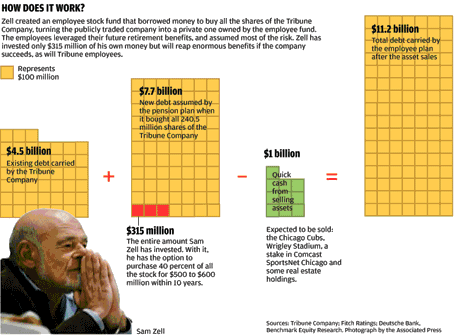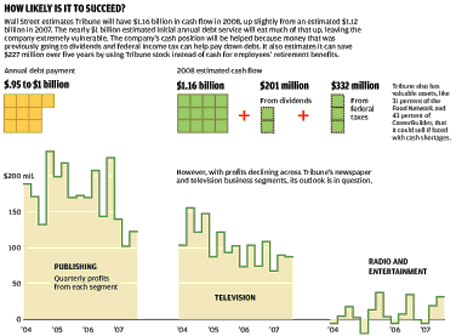When the Tribune Company went private in December, Sam Zell completed a deal that many had said he couldn’t get done. Now comes the hard part—staying solvent.
In an unusual two-phase deal, an Employee Stock Ownership Plan set up by Zell borrowed nearly $8 billion on Wall Street to buy all 240 million of Tribune’s outstanding shares, taking the company private and leaving the employee plan holding all of the stock. The real-estate tycoon put in just $315 million of his own money and got the right to buy about 40 percent of the company’s stock for $500 to $600 million over the next decade.
The ESOP gives Tribune Company workers a big stake in the future of the company, but little say in what that future will be. Despite his small investment, Zell became chairman and ceo as part of the deal. The company loaded itself up with so much debt that it will struggle to pay the interest—about $1 billion a year. As you see below, that is nearly as much as its 2008 estimated cash flow. Tribune has little room for error.

[Click here for a larger graphic.]
A blunt-talking motorcycle rider who wears jeans and cowboy boots to Wall Street meetings, Zell is known for impeccable timing, which he displayed in February when he sold Equity Office Properties Trust for $39 billion, a record price at commercial real estate’s peak. When he made his bid for Tribune last April, he got commitments from banks in the midst of a lending frenzy. That wouldn’t have happened even three months later, as the lending environment began to unravel.
But since April, Tribune’s outlook has dimmed. Its publishing revenues fell 7 percent in the third quarter. That, in turn, has bond markets on edge. The price of insuring Tribune debt in the credit-default-swaps market implies a likelihood of default in the next five years of more than 80 percent, an enormous number for a company fresh off a deal, though one that’s inflated by the panicked state of the credit markets. In February, Zell announced that the company would lay off up to five hundred employees—about two percent of its workforce—because of continued deterioration in advertising revenues, and thus cash flow.
A default wouldn’t necessarily mean bankruptcy, since Tribune could try to negotiate new terms with creditors. But that’s small solace for employees being asked to tie up future retirement savings in a company staggering under debt. Under the ESOP, Tribune ended its payments to employees’ 401(k)s and will instead fund their retirements with company stock equal to five percent of salary. (It will also put three percent in a cash-balance plan.)
Still, Tribune has something of a chance. Zell used an ESOP because the employee-owned structure eliminates federal income tax, which cost Tribune an average $332 million a year from 2004 to 2006. Tribune will also no longer pay a dividend, which saves $201 million a year. And by paying employees with stock instead of cash, it will save tens of millions of dollars more annually. All that will give the company a cash-flow cushion. Zell has also said he will sell some assets to pay down debt, and count on him to eventually make money on the company’s real estate. By 2012, Tribune expects to have 17 percent of its debt paid down, and nearly half of the debt paid down within a decade.

[Click here for a larger graphic.]
Zell is known as the Grave Dancer, for buying distressed real estate on the cheap. Succeeding with Tribune depends on arresting the alarming pace of deterioration at its newspapers—thus the fresh tensions at the Los Angeles Times and elsewhere. If the company’s revenues continue to plunge, no amount of financial engineering will save it, and Zell may instead be called the Grave Digger.


 Archives:
Archives: